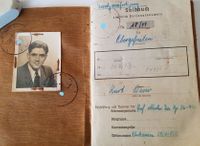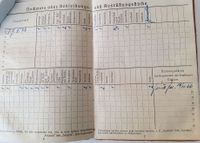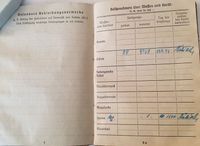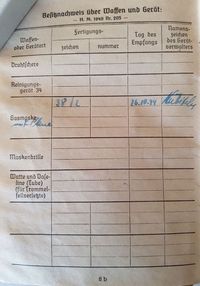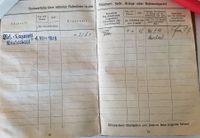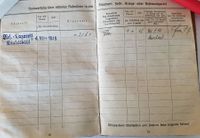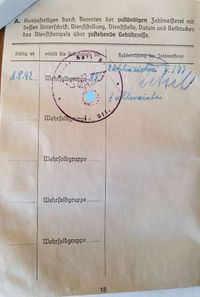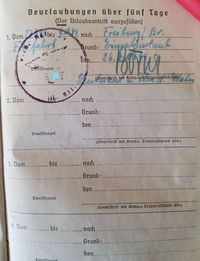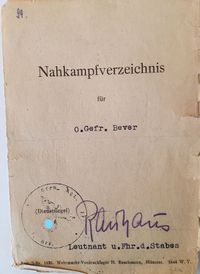Soldbuch of a member of the 26. Volksgrenadier-Division
Soldbuch of Obergefreiter Kurt Bever. This Zweitschrift (pity) example was issued November 14th 1944 when Bever was joining the (re)formation of Grenadier-Regiment 77 of the 26. Volksgrenadier-Division (VG) in the Warthelager. It was reconstituted into a Volksgrenadier-Division in September 1944. The newly formed Volksgrenadier-Division arrived at the Eifel area in october 1944.
At this point, Bever was a battle hardened Eastern Front veteran of the regiment, who had earned five combat awards: The EK II, the Verwundetenabzeichen in Schwarz, the Ostmedaille, the Verwundetenabzeichen in Silber and and the Infanterie-Sturmabzeichen in Silber which he received on 10/29/44. He also achieved a total of 10 close combat days in 1941/ 42, which can be seen on the great list of his Nahkampftage. He probably participated in many battles on the road to Moscow and the Smolensk area.
After being severely decimated on the retreat from Moscow and the battle of Kursk, Bever and his division were moved to the Western Front and involved the Ardennes Offensive. Bever was given some leave (Nachturlaub) from 10/14 to 10/31 to the city of Posen. The 26th VG-Division were assembled at the Neuerburg area at the beginning of the battle The 39th and 77th grenadier regiments would be working together. The 77th was deployed in the heart of the action and advanced towards Bastogne. Bever's I. Bataillon (lead by Captain Weber) of Grenadier-Regiment 77 was already the division's spearhead on the very first day of the offensive, December 16th, during the attack on the Americans in Hosingen (which they actually by passed) and then on to Bockholz and Drauffelt (Luxemburg), where they built a bridgehead on the river Clerf where they were up against the American 28th ‘Bloody Bucket’ Division. The 130th and 26th Reconnaisance Battalions from the Panzer-Lehr-Division would go on to exploit the 77th penetration. The 77th reached the outskirts of Bastogne (Bizory, Neffe) on the 19th, and undertook numerous attacks to breach through the defensive lines of the American paratroopers. When the 26.VGD was finally pushed back from the Ardennes and retreated into the Eifel, Bever was wounded by shrapnel in february 1945. He arrived at the Reservelazarett Dinkelsbühl on march 4th and appears to have survived the war.
Indicator for the Grenadier-Regiment 77 in this Soldbuch is the stamp on the second picture and the battles shown on the last picture. All this battles are of the 77. This page is signed by Oberleutnant Rahaus. (Thank You for the tip, Pierre Darligue)
